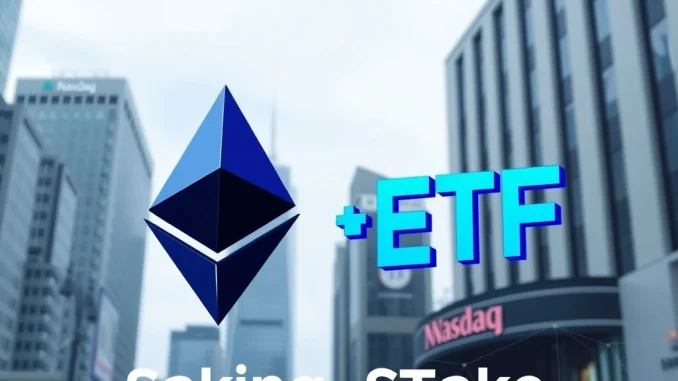
The cryptocurrency world is abuzz with news that could redefine how investors access digital assets. Nasdaq has submitted a groundbreaking proposal to the Securities and Exchange Commission (SEC) to integrate staking into the iShares Ethereum Trust exchange-traded fund (ETF). This isn’t just another filing; it’s a potential game-changer for the Ethereum ETF landscape, signaling a deeper convergence between traditional finance and the innovative world of decentralized technology.
For years, the crypto community has yearned for easier, regulated avenues for mainstream investors to participate. While Bitcoin ETFs have recently opened doors, the inclusion of staking in an Ethereum ETF takes this accessibility to an entirely new level. Imagine earning passive income from your Ethereum holdings without the complexities of self-custody or managing validator nodes. That’s the promise Nasdaq’s latest move holds.
What Does Nasdaq’s Historic ETH Staking Proposal Mean?
At its core, ETH staking is a fundamental mechanism of the Ethereum blockchain’s Proof-of-Stake (PoS) consensus mechanism. Instead of energy-intensive mining (Proof-of-Work), validators lock up a certain amount of Ether (ETH) to participate in securing the network, processing transactions, and creating new blocks. In return for their service, they earn rewards, essentially a yield on their staked assets.
Now, envision this mechanism applied to an ETF. Traditionally, an ETF holding an asset like gold or stocks simply tracks its price. A spot crypto ETF holds the underlying cryptocurrency. But by adding staking, the iShares Ethereum Trust ETF wouldn’t just hold ETH; it would actively participate in the Ethereum network, generating additional returns for its investors. This is a significant evolution for a financial product.
- Passive Income: Investors would potentially earn yield on their ETH holdings within the ETF, adding a new dimension to their returns beyond just price appreciation.
- Network Security: The staked ETH would contribute to the overall security and decentralization of the Ethereum network.
- Simplified Access: Retail and institutional investors could gain exposure to staking rewards without the technical knowledge or infrastructure required to run a validator node.
This move is particularly noteworthy because it bridges a gap. While many crypto enthusiasts are familiar with staking, traditional finance has largely viewed digital assets through a lens of price speculation. Integrating staking brings a yield-generating component, akin to dividends from stocks or interest from bonds, making the asset class more appealing to a broader range of investors seeking income streams.
Unpacking the iShares Ethereum Trust ETF Filing
The iShares Ethereum Trust is BlackRock’s proposed spot Ethereum ETF. BlackRock, a titan in the asset management industry with trillions under management, has a history of pioneering financial products. Their entry into the crypto ETF space, starting with Bitcoin, signaled a massive shift in institutional sentiment. The decision to include staking in their Ethereum offering through Nasdaq’s filing further underscores their commitment to providing comprehensive crypto exposure.
The filing outlines how the trust would engage in staking. Typically, this involves using a trusted third-party staking provider, such as Coinbase Custody, which is often named as the custodian in such applications. This ensures the security and operational integrity of the staked assets. The revenue generated from staking would then be converted back into ETH and reinvested into the trust, theoretically increasing the net asset value (NAV) of the ETF over time, or potentially distributed to shareholders.
Key considerations in the filing include:
- Custodian’s Role: The choice of a reputable and secure custodian is paramount to ensure the safety of the underlying ETH.
- Staking Strategy: Details on how the staking operations would be managed, including selection of validators and handling of rewards.
- Fee Structure: How the staking revenue would impact the overall expense ratio of the ETF.
This transparency is crucial for regulatory approval and investor confidence. The inclusion of staking is not a trivial addition; it requires careful consideration of the operational, security, and financial implications for the trust and its investors.
The Broader Impact on Crypto Investment and Market Dynamics
A successful launch of an Ethereum ETF with staking capabilities could trigger a domino effect across the broader Crypto investment landscape. Here’s why:
- Increased Institutional Adoption: ETFs are a familiar and regulated investment vehicle for institutions. Adding staking makes ETH more attractive by offering a yield, which aligns with traditional investment strategies. This could unlock significant capital flows from pension funds, endowments, and wealth managers who previously couldn’t or wouldn’t directly hold cryptocurrencies.
- Enhanced Market Legitimacy: Regulatory approval of a staking-enabled ETF would lend further credibility to Ethereum and the entire crypto market. It signifies that regulators are becoming more comfortable with the nuanced aspects of blockchain technology beyond just simple asset holding.
- Potential Price Impact: Increased demand from institutional and retail investors funneled through an ETF could put upward pressure on ETH’s price. Furthermore, ETH being locked up for staking (even indirectly through the ETF) reduces the circulating supply, which can also be a bullish factor.
- Innovation Catalyst: This development could pave the way for other innovative crypto ETFs that incorporate various DeFi (Decentralized Finance) strategies, such as lending or liquidity provision, further blurring the lines between traditional finance and crypto.
This is not just about Ethereum; it’s about setting a precedent for how traditional financial products can integrate with the evolving functionalities of blockchain networks. It moves crypto from a speculative asset to a productive one within a regulated framework.
Navigating the Nasdaq SEC Filing: What’s Next?
The Nasdaq SEC filing is now in the hands of the U.S. Securities and Exchange Commission, a body known for its cautious approach to novel financial products, especially in the crypto space. The SEC’s primary mandate is investor protection, and they will scrutinize every aspect of this proposal.
The approval process for an ETF is typically lengthy and involves several stages:
- Initial Review: The SEC staff reviews the proposal for completeness and adherence to existing regulations.
- Public Comment Period: The proposal is published, allowing the public, industry participants, and experts to submit comments. These comments can be influential.
- Delays and Amendments: It’s common for the SEC to request additional information or amendments to the filing. This can lead to multiple delays, sometimes extending the process for months or even years.
- Decision: Ultimately, the SEC will either approve, disapprove, or postpone a decision.
Historically, the SEC has expressed concerns about market manipulation, custody risks, and the nascent nature of crypto markets. However, the recent approvals of spot Bitcoin ETFs, along with increasing clarity around Ethereum’s regulatory status (especially after the move to PoS), suggest a potential shift in the SEC’s stance. The fact that staking is involved adds another layer of complexity, as it introduces operational aspects beyond simple asset holding.
The timeline for approval remains uncertain. While the Bitcoin ETF approvals set a precedent, each crypto asset and its unique features (like staking) will undergo rigorous independent review. Market participants will be closely watching for any signals or further requests from the SEC.
Why Ethereum ETF Staking is a Game Changer
The potential for an Ethereum ETF that includes staking is truly revolutionary. It addresses several pain points for traditional investors looking to enter the crypto space, while simultaneously enhancing the utility and appeal of Ethereum itself.
Benefits for Investors:
- Ease of Investment: No need to set up crypto wallets, understand private keys, or navigate decentralized exchanges. Invest through a traditional brokerage account.
- Diversification: Offers a new way to diversify portfolios with a yield-generating digital asset.
- Regulatory Oversight: Operates under the SEC’s purview, providing a layer of investor protection not always present in direct crypto investments.
- Liquidity: ETFs are highly liquid, allowing for easy buying and selling on major exchanges.
- Income Generation: The unique ability to earn staking rewards within a regulated product.
Challenges and Risks:
- Slashing Penalties: If a validator node misbehaves (e.g., goes offline or double-signs transactions), staked ETH can be penalized (slashed). While the ETF would likely use professional staking providers, this risk remains.
- Lock-up Periods: Staked ETH might be subject to lock-up periods, affecting the ETF’s liquidity management, though the ETF structure aims to mitigate this for investors.
- Regulatory Uncertainty: Future regulatory changes regarding staking or cryptocurrencies could impact the ETF.
- Performance Fees: Staking service providers and the ETF manager will charge fees, which will reduce the net yield passed on to investors.
- Centralization Concerns: Large amounts of ETH staked by a few institutional entities could raise concerns about centralization of validator power, though BlackRock/iShares would likely use diversified staking pools.
Despite the challenges, the overall sentiment is overwhelmingly positive. This move by Nasdaq and BlackRock signals a maturity in the crypto market and a willingness from traditional finance to embrace its innovative aspects beyond just price speculation.
Conclusion: A New Horizon for Crypto Investment
Nasdaq’s proposal to add staking to the iShares Ethereum Trust ETF marks a pivotal moment in the evolution of crypto investment. It represents a bold step towards integrating the innovative yield-generating capabilities of decentralized finance into the regulated world of traditional finance. While the journey through SEC approval will undoubtedly have its hurdles, the sheer potential of an Ethereum ETF that offers staking rewards is immense.
This development isn’t just about making Ethereum more accessible; it’s about redefining what an ETF can be and how investors can participate in the digital economy. It paves the way for a future where the line between traditional and decentralized finance becomes increasingly blurred, opening up new horizons for wealth creation and financial innovation. The eyes of the financial world are now firmly fixed on the SEC, eagerly awaiting the next chapter in this unfolding saga.
Frequently Asked Questions (FAQs)
1. What is Ethereum staking?
Ethereum staking is the process of locking up a certain amount of Ether (ETH) to act as a validator on the Ethereum blockchain. Validators are responsible for verifying transactions and creating new blocks. In return for their participation and securing the network, they earn staking rewards (new ETH).
2. How would an iShares Ethereum Trust ETF with staking work?
The ETF would hold Ether (ETH) as its underlying asset. A portion of this ETH would then be staked with a professional staking provider (like Coinbase Custody). The rewards generated from this staking activity would be reinvested into the trust, potentially increasing the ETF’s net asset value, or could be distributed to shareholders, depending on the ETF’s structure and regulatory approvals.
3. What are the main benefits for investors?
For investors, the primary benefits include gaining exposure to Ethereum’s price appreciation and earning passive income from staking rewards, all within a familiar, regulated ETF structure. This simplifies access, removes the need for technical expertise in managing crypto, and offers the liquidity of a publicly traded fund.
4. What are the potential risks of such an ETF?
Risks include potential slashing penalties if the staking provider’s validator nodes misbehave, the inherent volatility of cryptocurrency prices, regulatory changes impacting the ETF’s operations, and the fees charged by the ETF manager and staking service providers, which would reduce net returns.
5. What is the SEC’s process for approving this proposal?
The SEC will conduct a thorough review of Nasdaq’s filing, including assessing its compliance with securities laws, market manipulation concerns, and investor protection measures. This involves public comment periods and potential requests for amendments, making it a lengthy process with an uncertain timeline.
6. When could the iShares Ethereum Trust ETF with staking be approved?
There is no definitive timeline for approval. While the recent approvals of spot Bitcoin ETFs might set a precedent, the inclusion of staking adds complexity. The process could take several months or even longer, depending on the SEC’s review and any potential requests for further information or modifications.



